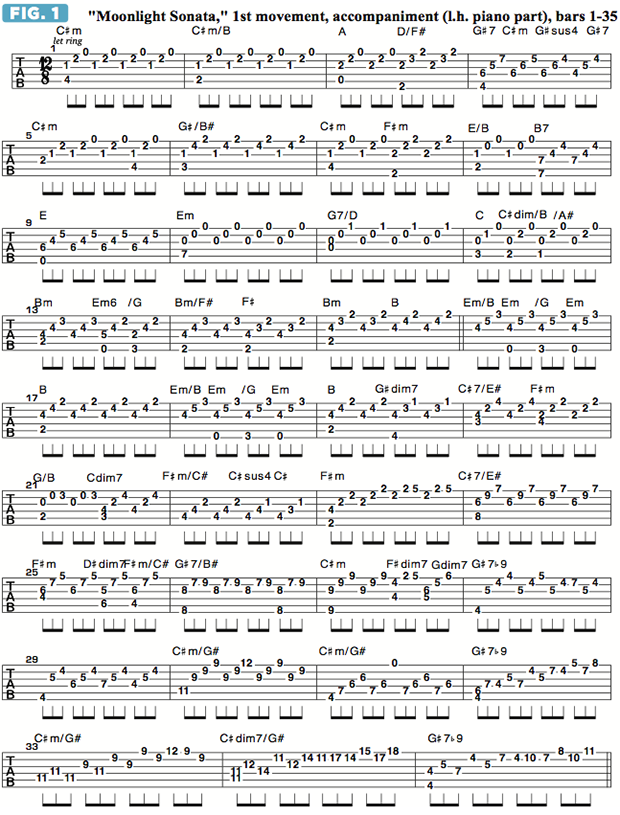How to Play the Dreamy Arpeggios in Beethoven’s “Moonlight Sonata”
Learn this neat, May and Gilmour-influenced guitar arrangement of “Moonlight Sonata.”

For more than 20 years, I’ve had this idea in my head for a cool classic rock-style arrangement of Ludwig Van Beethoven’s famous piano piece, “Moonlight Sonata,” specifically the slow first movement (Adagio), which features a hauntingly beautiful chord progression unfolding as hypnotic triplet arpeggios supporting a sparse, poignant melody.
My idea, which I’ve finally written down, recorded and am excited to now share with you, was to arrange the piano’s left- and right-hand parts for two electric guitars—rhythm and lead—with bass and drums accompaniment, in a dramatic, British hard/prog-rock style inspired by Pink Floyd’s “Shine On You Crazy Diamond,” Led Zeppelin’s “Since I’ve Been Loving You” and Brian May’s playing on the Queen songs “We Are the Champions” and “In the Lap of the Gods…Revisited” (Sheer Heart Attack).
Here I present approximately the first half of the left-hand piano part—the accompaniment—which I perform with a slightly dirty bridge-pickup tone and a generous amount of concert-hall reverb, which helps emulate the ringing piano sound Beethoven achieved by using that instrument’s sustain pedal (see FIGURE 1).
This part of the arrangement has you playing an unbroken stream of slow, steady eighth-note-triplet arpeggios, à la Chicago’s “Color My World,” and requires some practice to master, as you will need to anticipate some of the challenging fingerings. It’s mostly flatpicked single notes, but you will need to use hybrid picking (pick-and-fingers technique) in order to simultaneously pluck two notes on non-adjacent strings on most of the chord changes.
First, familiarize yourself with the chord shapes, making sure your fretting fingers are properly positioned, then work on the picking, striving for an even triplet rhythm throughout. The goal is to try and allow the arpeggios and bass notes to ring together as much as possible, although that becomes impossible in the last half of bars 34 and 35, where you need to let go of the bass note as your fret hand shifts up the neck to play the extended diminished arpeggios.
This is where the thick reverb helps to emulate the piano’s sustain pedal function. As you’ll hear in the video performance online, I added a bass guitar part, which octave doubles the built-in bass line and sustains the low notes during these parts. I also doubled the bass notes with a lightly overdriven single-note guitar (double-tracked and panned hard left and right), which is the Brian May/Queen influence I mentioned earlier.
Next month I’ll show you the remainder of the arpeggio part, then we’ll move on to the melody, which features lots of wailing string bends and vibratos, played with a high-gain lead tone, à la Pink Floyd’s David Gilmour.

Get The Pick Newsletter
All the latest guitar news, interviews, lessons, reviews, deals and more, direct to your inbox!
Over the past 30 years, Jimmy Brown has built a reputation as one of the world's finest music educators, through his work as a transcriber and Senior Music Editor for Guitar World magazine and Lessons Editor for its sister publication, Guitar Player. In addition to these roles, Jimmy is also a busy working musician, performing regularly in the greater New York City area. Jimmy earned a Bachelor of Music degree in Jazz Studies and Performance and Music Management from William Paterson University in 1989. He is also an experienced private guitar teacher and an accomplished writer.
“There are so many sounds to be discovered when you get away from using a pick”: Jared James Nichols shows you how to add “snap, crackle and pop” to your playing with banjo rolls and string snaps
Don't let chord inversions bamboozle you. It's simply the case of shuffling the notes around








![Joe Bonamassa [left] wears a deep blue suit and polka-dotted shirt and plays his green refin Strat; the late Irish blues legend Rory Gallagher [right] screams and inflicts some punishment on his heavily worn number one Stratocaster.](https://cdn.mos.cms.futurecdn.net/cw28h7UBcTVfTLs7p7eiLe.jpg)


